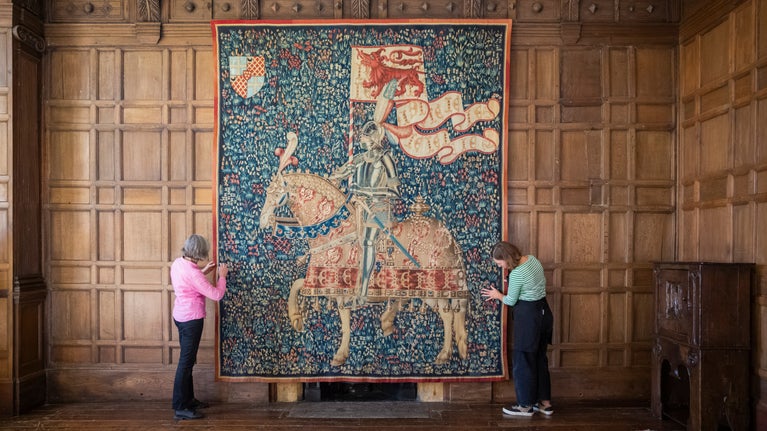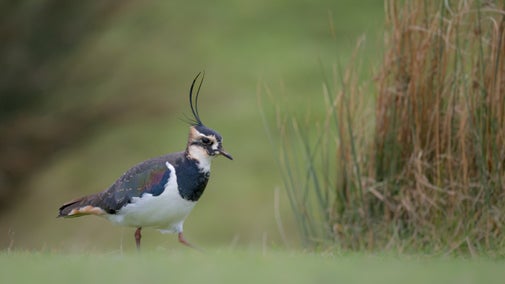
Preserving the past
From conserving historic works of art and delving into archaeology to supporting urban heritage and parks, find out about our vital conservation work.


What can you do if you discover that something has been feasting on your favourite woolly jumper, carpet or wallpaper? Hilary Jarvis, one of the National Trust’s Assistant National Conservators, shares insights and tips on identifying, preventing and eradicating some of the most common, and most damaging, insect pests.
Insects are a critical part of our ecosystem, making up more than 80 per cent of the animal kingdom. They are also a fact of life in our historic houses.
Many species, including spiders and ladybirds, are perfectly harmless. Others, like clothes moths and carpet beetles, are less welcome because of the damage they can wreak on the collections we take care of.
Only a tiny proportion of the UK’s insect species damage our collections and interiors. However, the few that do can become serious pests and cause irreversible harm in a short period of time.
Among the worst offenders are silverfish (Lepisma saccarina), the webbing clothes moth (Tineola bisselliella) and carpet beetles, of which there are several species.
These pests, or more usually their larvae, will happily graze on a host of objects including books, wallpaper, textiles and taxidermy.
But they're not the only species to watch out for. In 2021, we also had problems with the Australian spider beetle (Ptinus tectus) and the common booklouse (Liposcelis bostrychophila).
For more information, our friends at English Heritage have put together this poster, which features close-ups of the adults and larvae of some of the insect species that often find their way inside National Trust properties, and could turn up in your home too.
To deter unwanted insect guests at National Trust places, we adopt a preventive approach, combining the best traditional housekeeping methods with modern conservation science.
Here are some things you can do to help prevent insects from arriving in the first place.
Insects will find a way to get in, so do your best to seal up the obvious places.
If you have a chimney, birds can make nests in it, creating homes and food for insects. A sweep will help you to keep your chimney clear.
Adult beetles eat plant material but will come indoors to lay their eggs on your wool, silk, fur or feathered objects. Consider checking windows with plants close by regularly and aim to block the insects' route inside.
Bugs generally prefer warm, cosy environments, so keeping your home (or maybe a certain room) a few degrees cooler can help to prevent them from moving in.
Damp rooms and leaks can attract insects, as this is the environment they thrive in. Most insects struggle if the air is too dry.
Leave your wardrobe doors open from time to time to allow the air to circulate and to let in sunlight.
Make sure your favourite garments have been washed or dry cleaned before you pack them away, as moths rarely eat clean silk or wool.
Above all, our number one recommendation is good housekeeping, which really is the answer in most cases.

Historically, most of the houses that the National Trust cares for would have been closed at some point in the year, usually in the winter. House staff would have used this as an opportunity to strip rooms down and give them a thorough clean. They’d also be on the lookout for insect pests or damage.
This approach can be just as helpful in our own homes today. Insects like to be safe and undisturbed – on top of your general housekeeping, consider giving each space a really good spring clean every year.

Here are some steps you can take if you already have signs of pest damage in your home.
If you find a jumper with a hole in, pop it in a plastic bag and leave it in the freezer for about 14 days. This will kill any remaining moth eggs that you might not be able to see and which can survive the lower-temperature washing machine cycles we favour today.
Nibbled carpets are not easy to repair. Have a good go with the vacuum cleaner and consider tracing over the chewed area with a soft pencil on a piece of paper. This will give you a record of how big it is, and you'll then know for sure if more insects have found the same spot.
If circumstances like this we might considering using an insecticide.
At the National Trust we a use colourless, biodegradable chemical that is harmless to pets and humans. The residue can kill returning insect pests before they start nibbling.
You can find a range of products in most hardware stores these days.
We’ll never be rid of insects and generally find we can co-exist perfectly happily.
Our primary role at the National Trust is to ensure our special places are there to be enjoyed by everyone, for ever, so we need to be ready if we find too many critters getting overly comfortable.
Hopefully you're now a bit more insect-pest ready too!

From conserving historic works of art and delving into archaeology to supporting urban heritage and parks, find out about our vital conservation work.
Wearing gloves is actually more likely to damage precious books than using clean hands. Read our experts’ guidelines for handling books safely.

Discover why the issue of protecting historic surfaces from dust is important to conservation work.

Learn how innovations in country house communication technology, from sprung bells to early telephones, transformed the ways servants could be called upon.

Numbers of hazel dormice have declined rapidly over the last century as a result of loss of woodland habitats and competition for food. Learn about our work to protect these endangered mammals.

Learn about the top wildlife-friendly gardens in our care, all the different species thriving there and how we're putting nature at the heart of our work.

Many species that were once common are now under threat because of habitat degradation and intensive farming. Discover the conservation success stories.

Hedgerows and orchards provide food for insects, homes for wildlife and a spectacle of spring blossom for humans. However, they are disappearing from UK landscapes. Find out more about what we're doing to bring blossoming trees and hedgerows back.